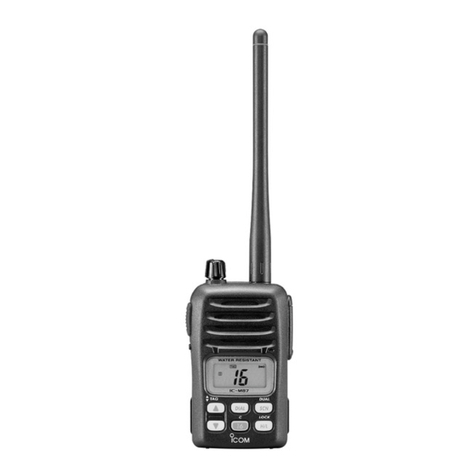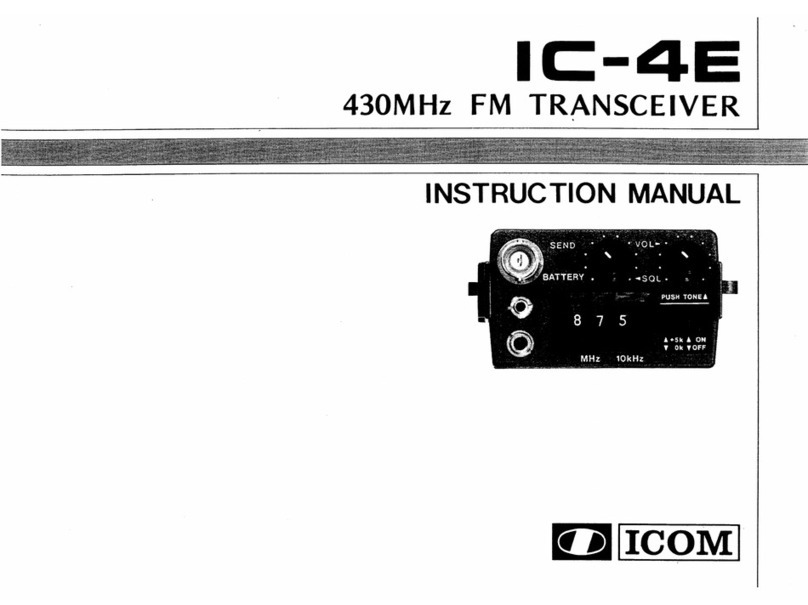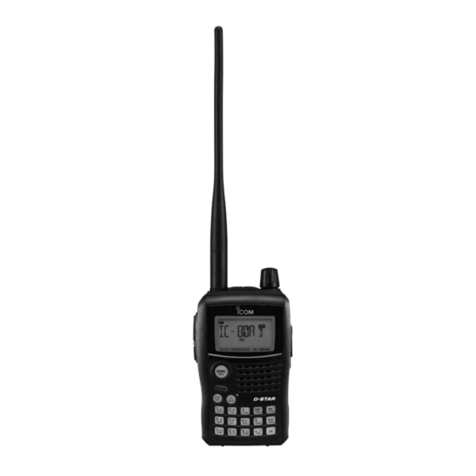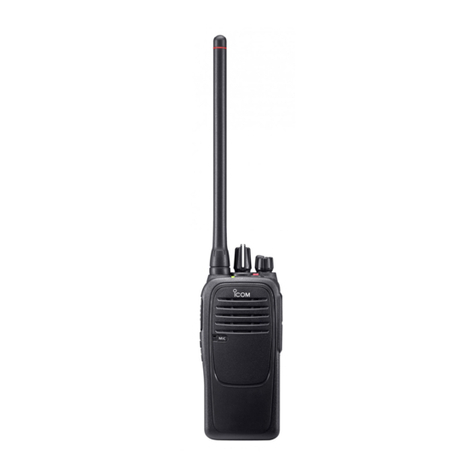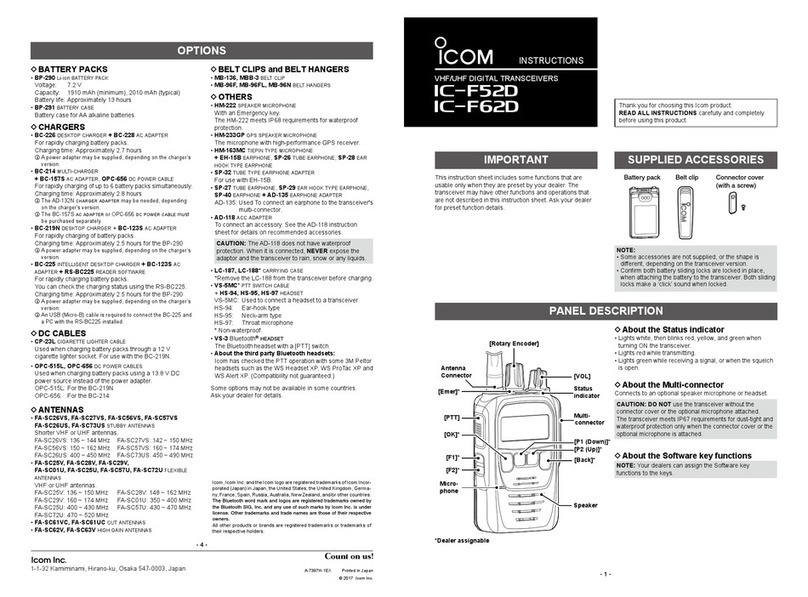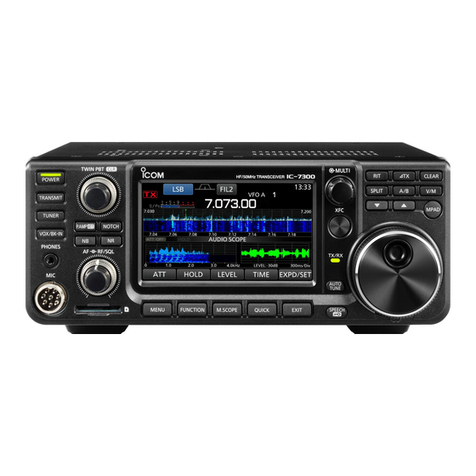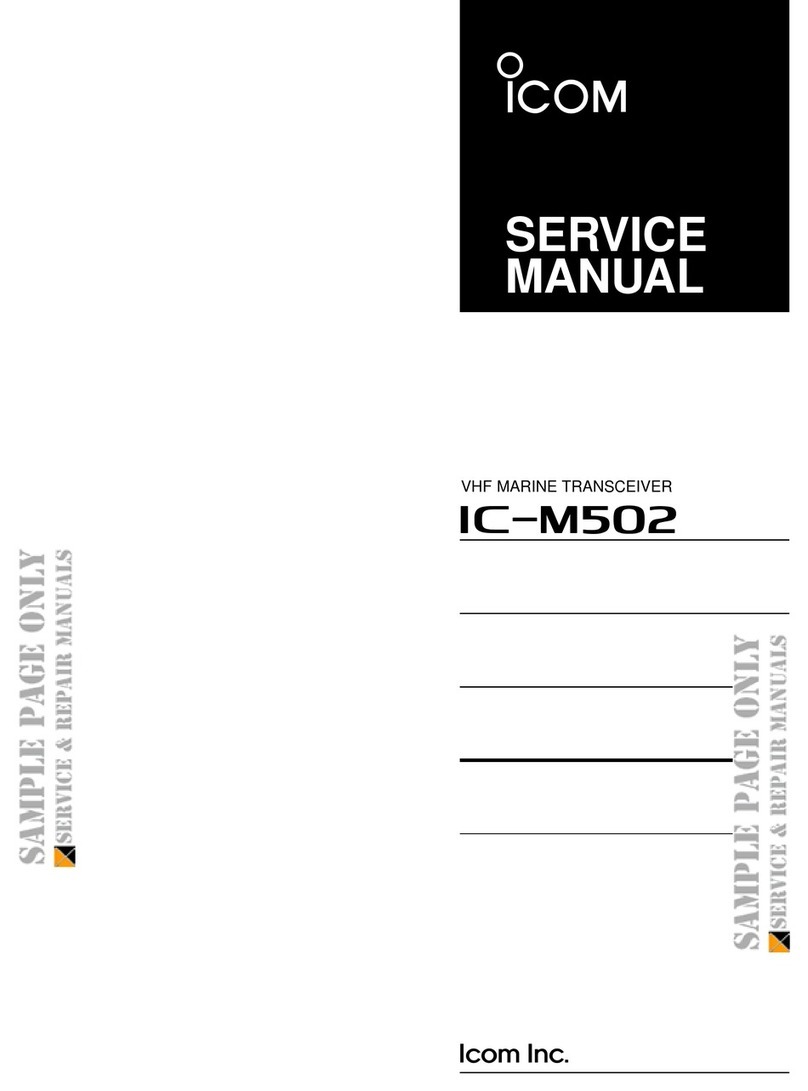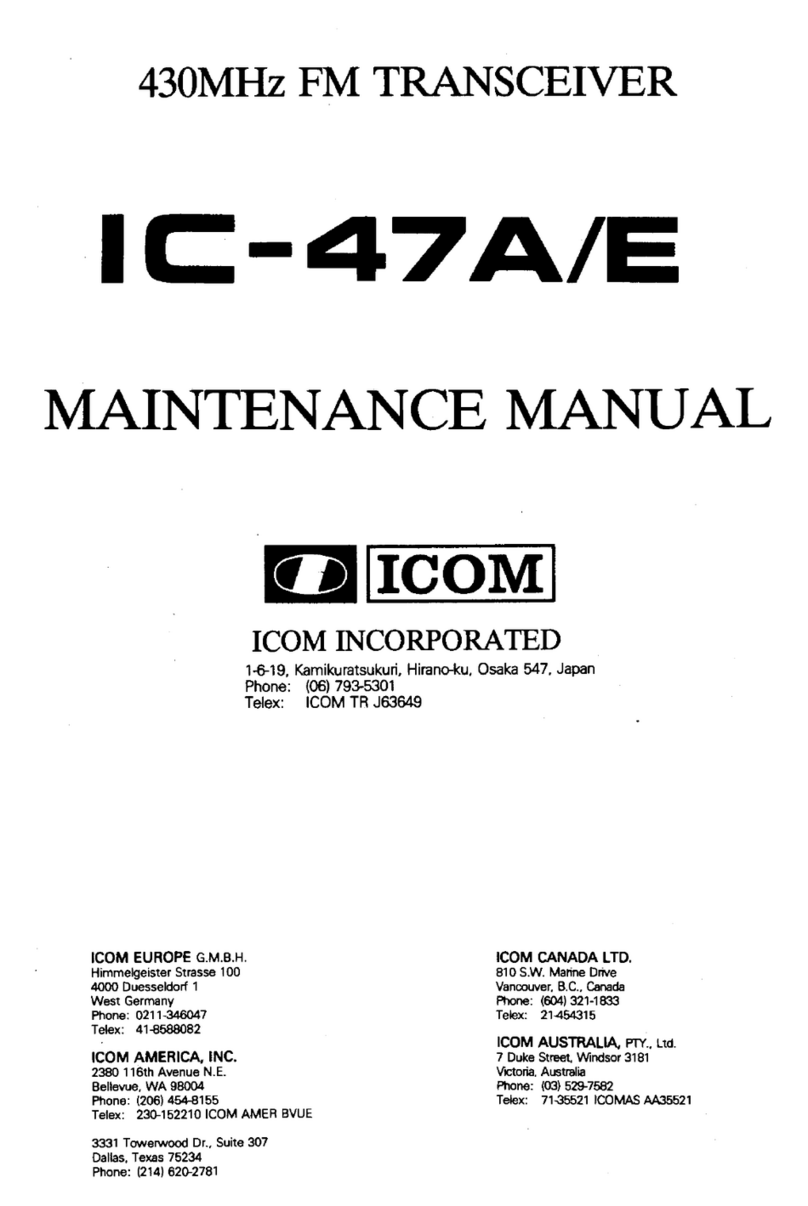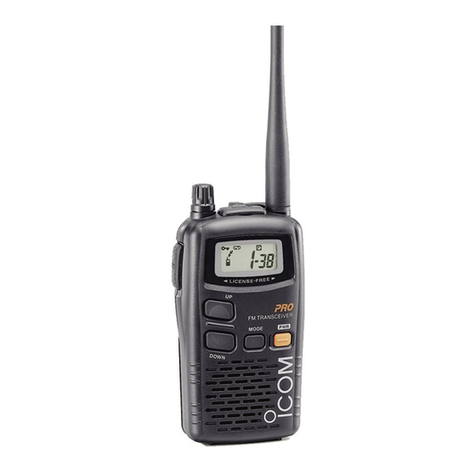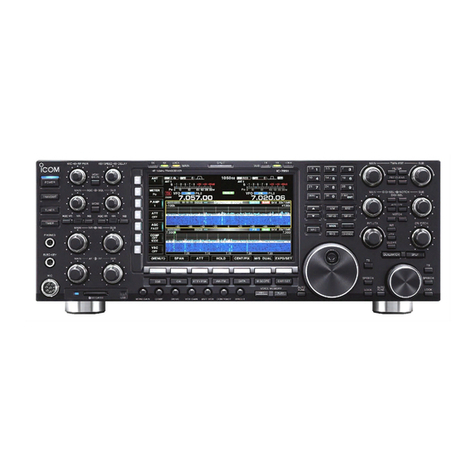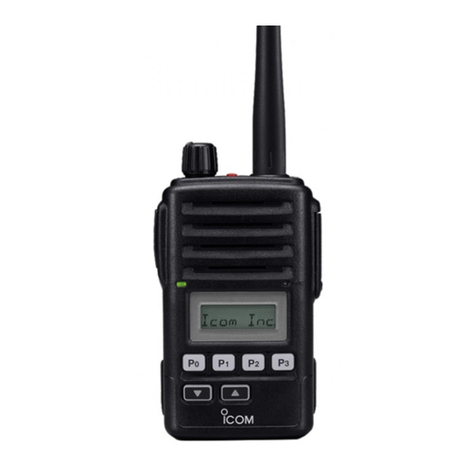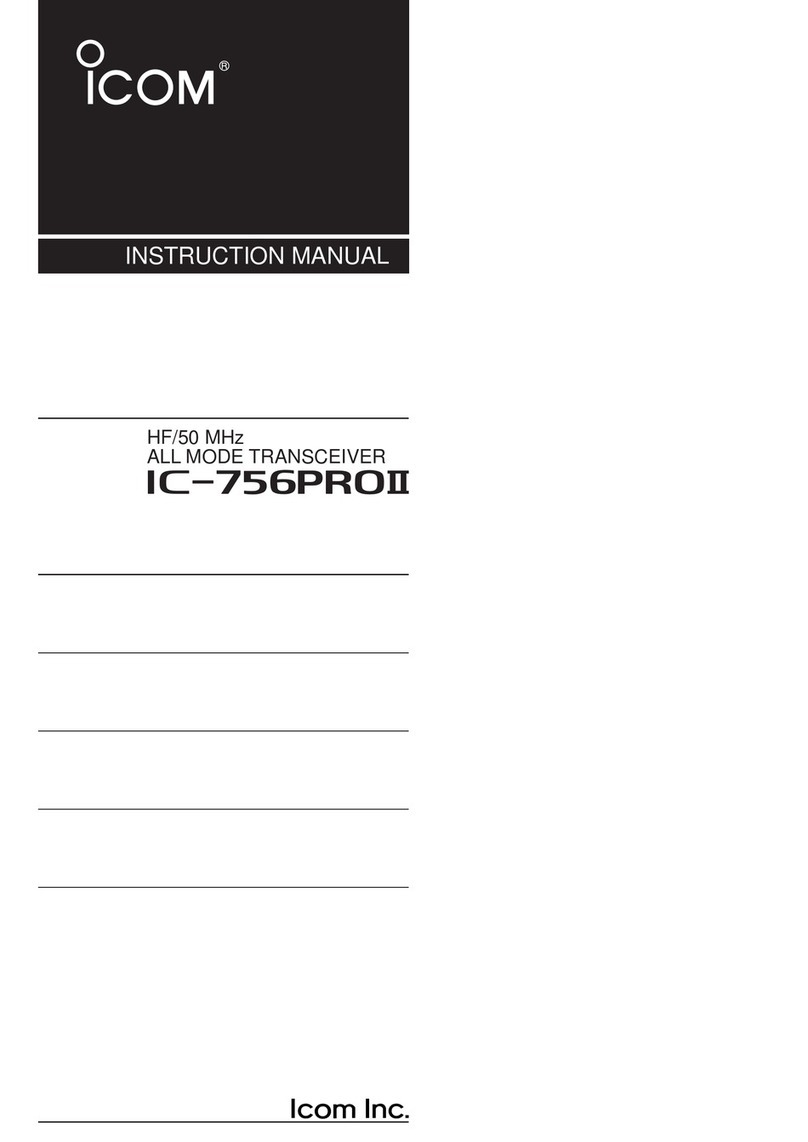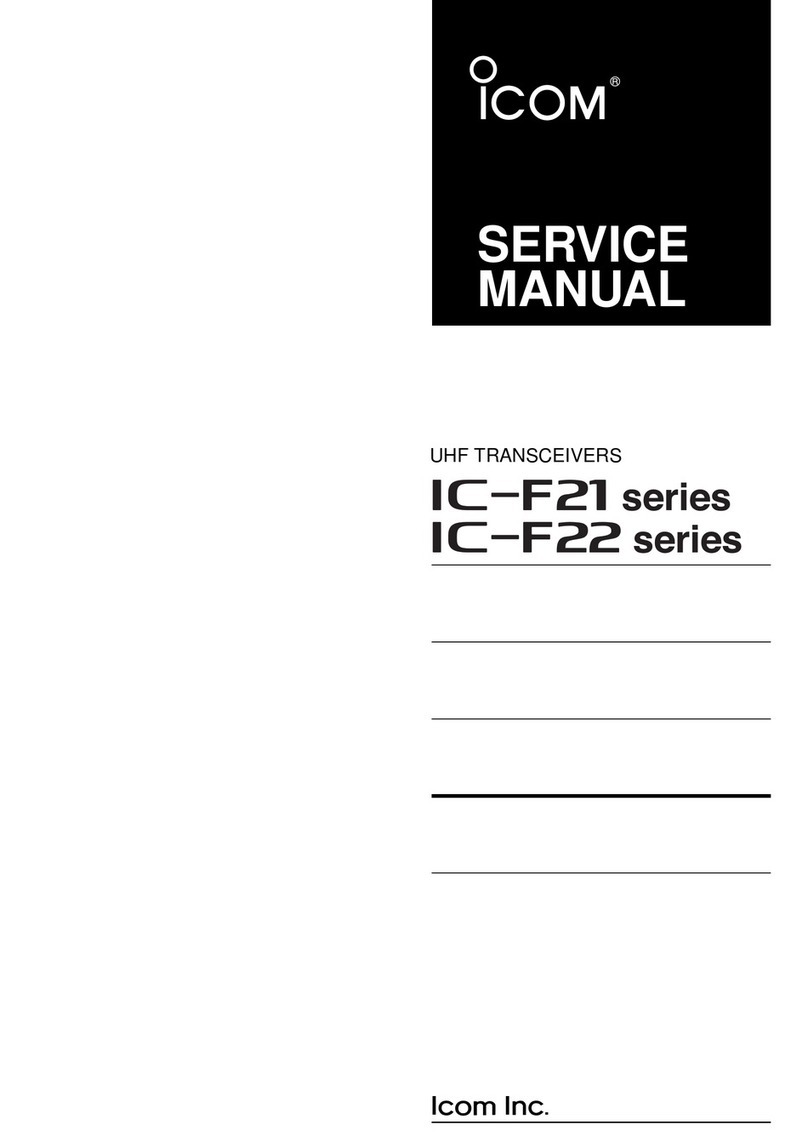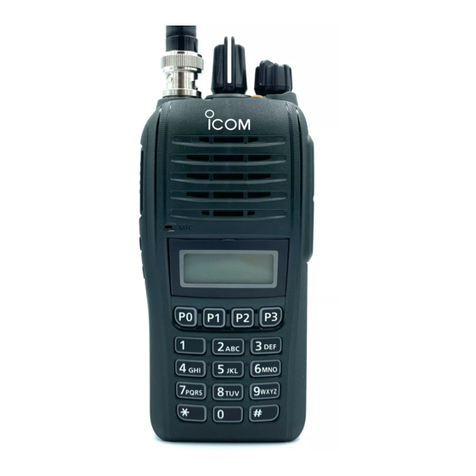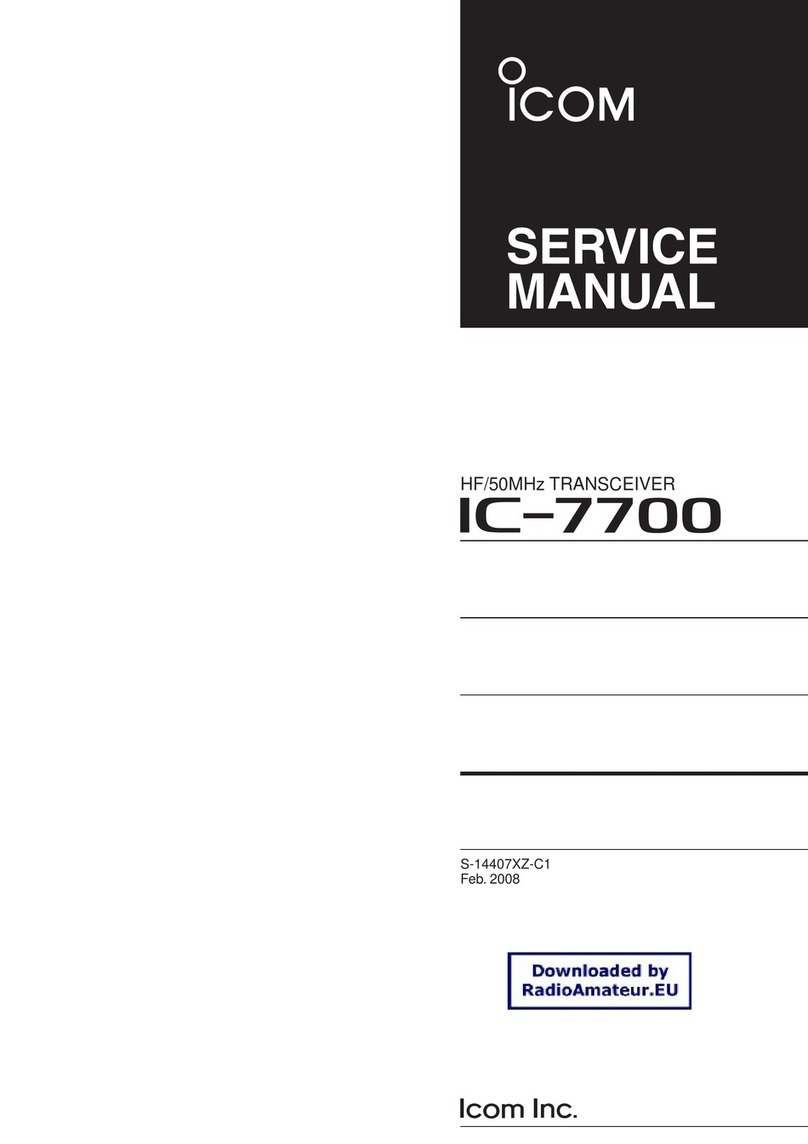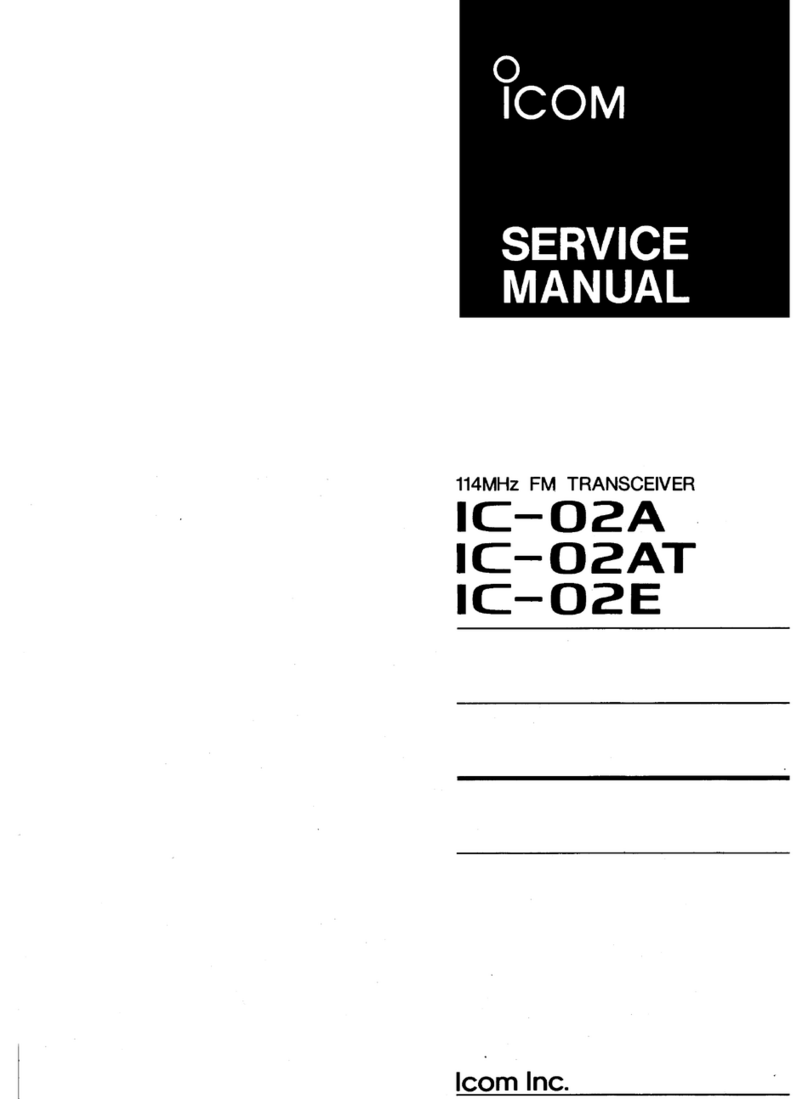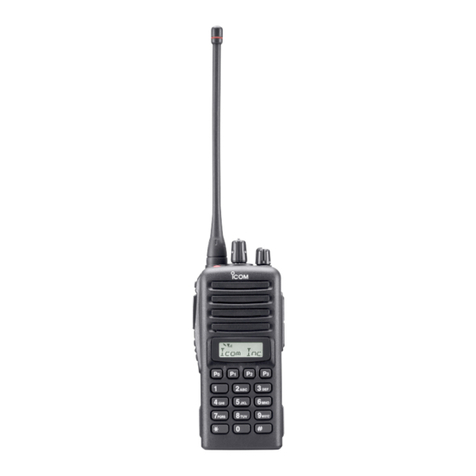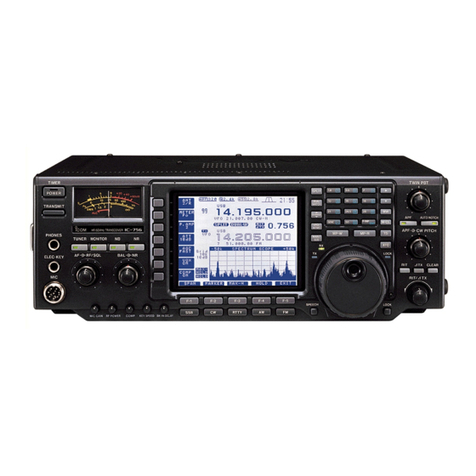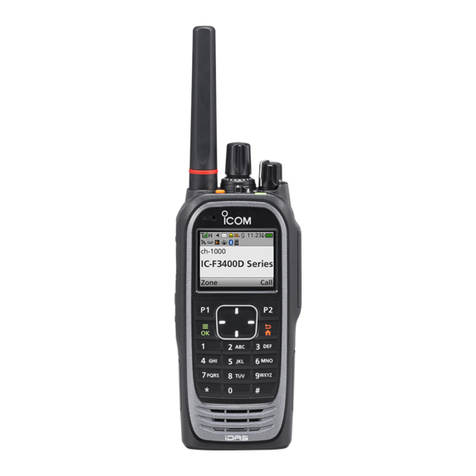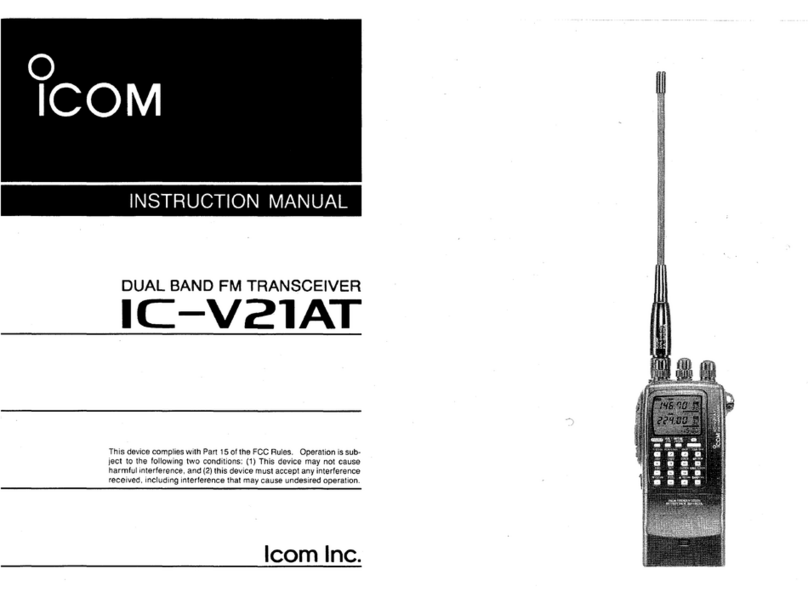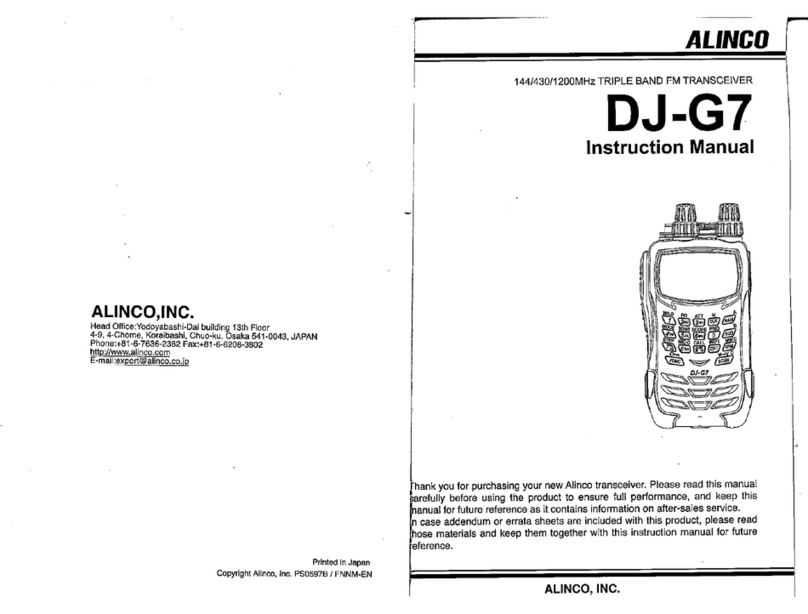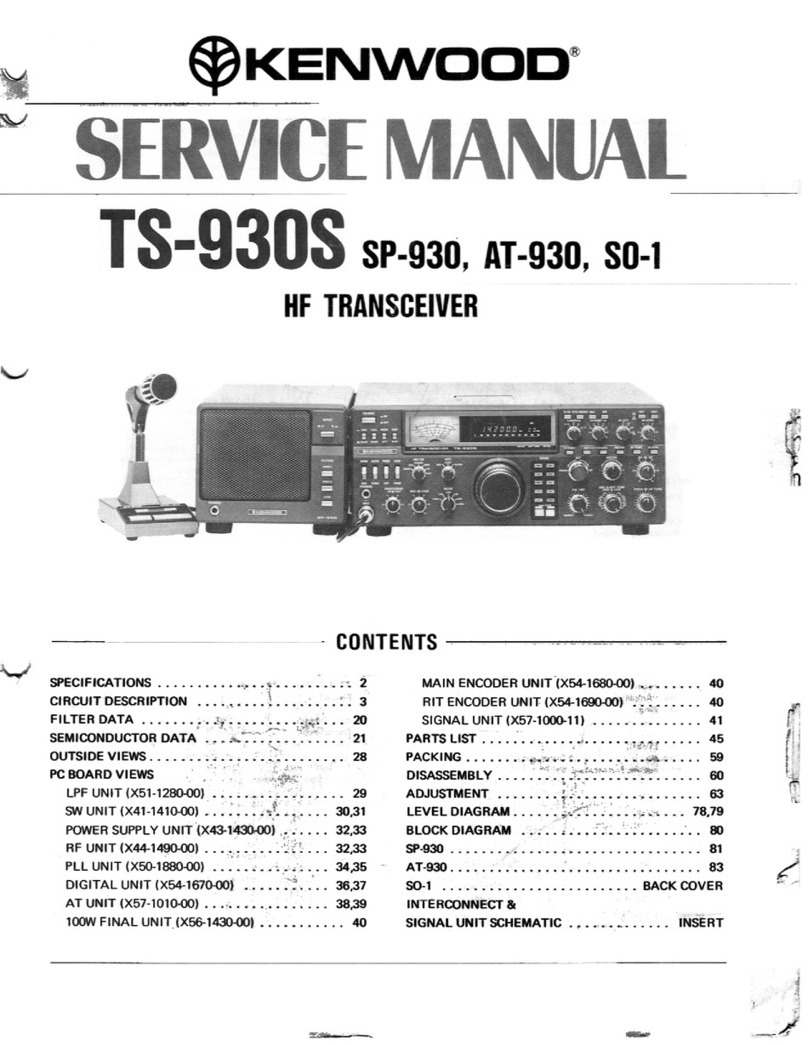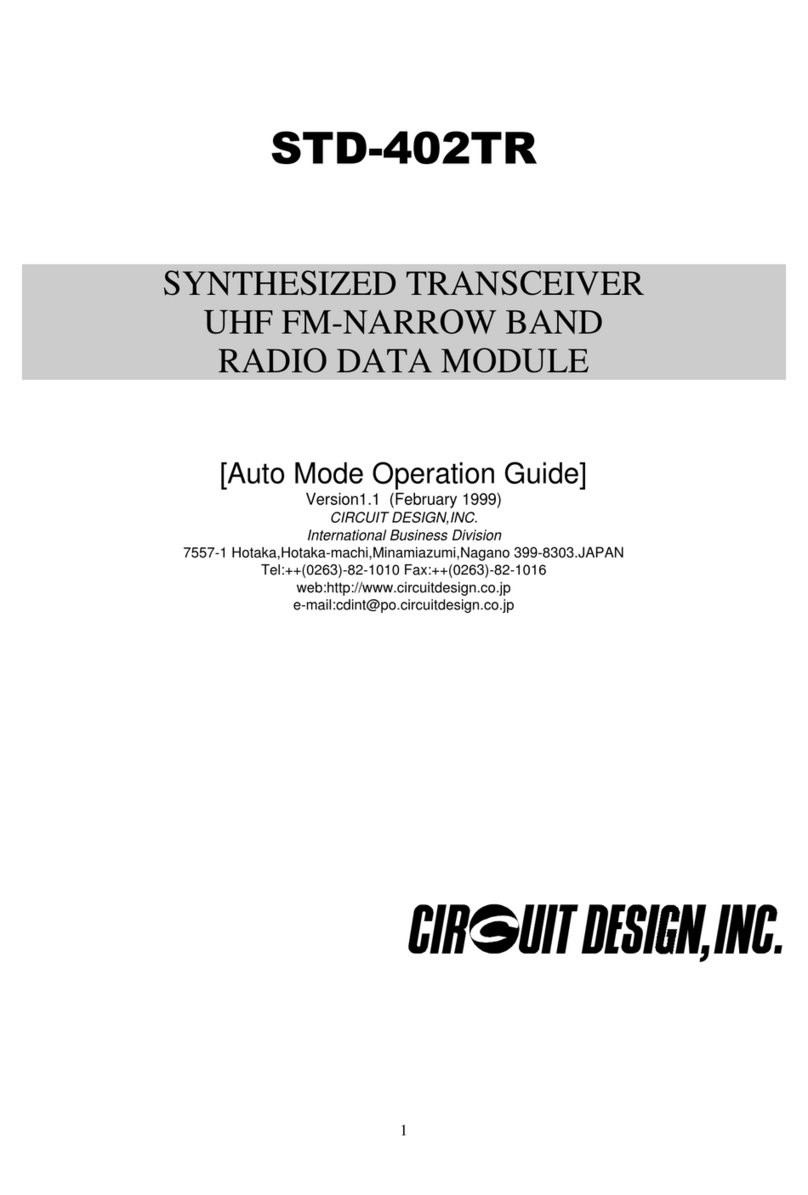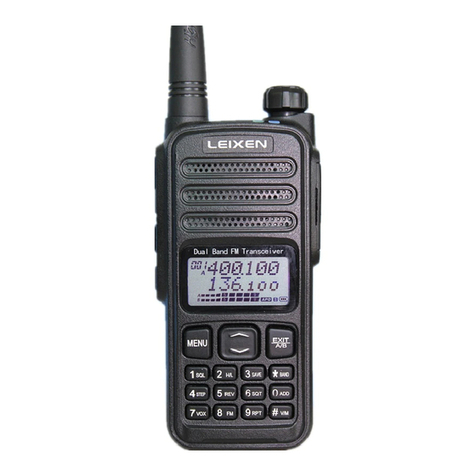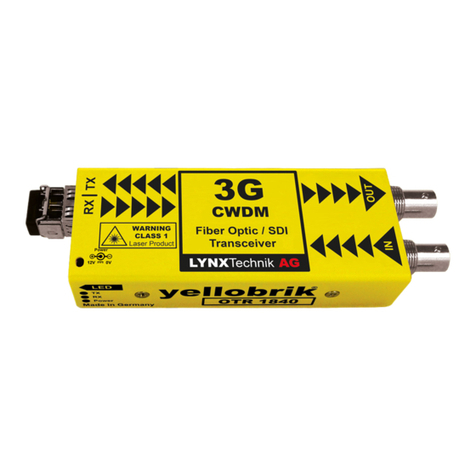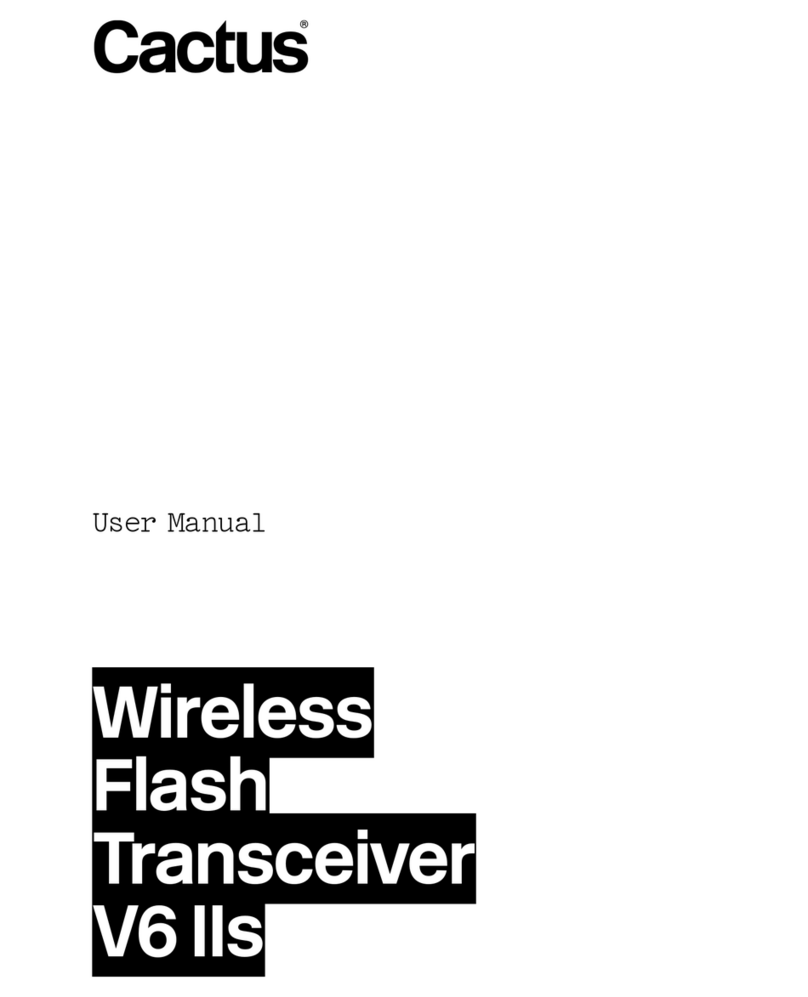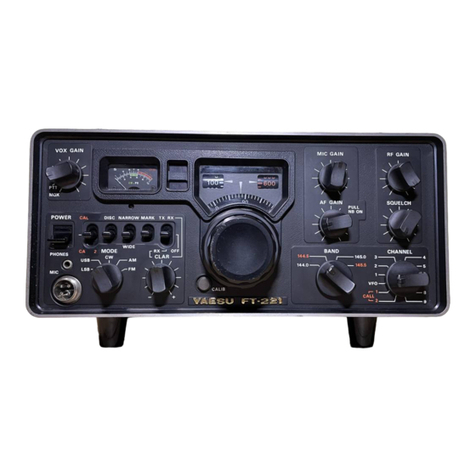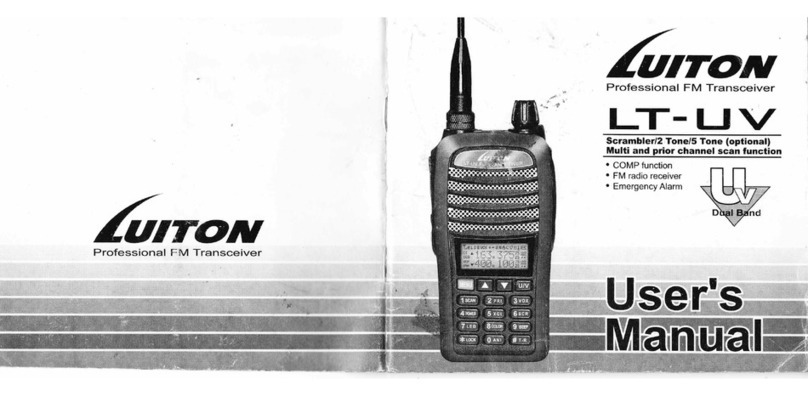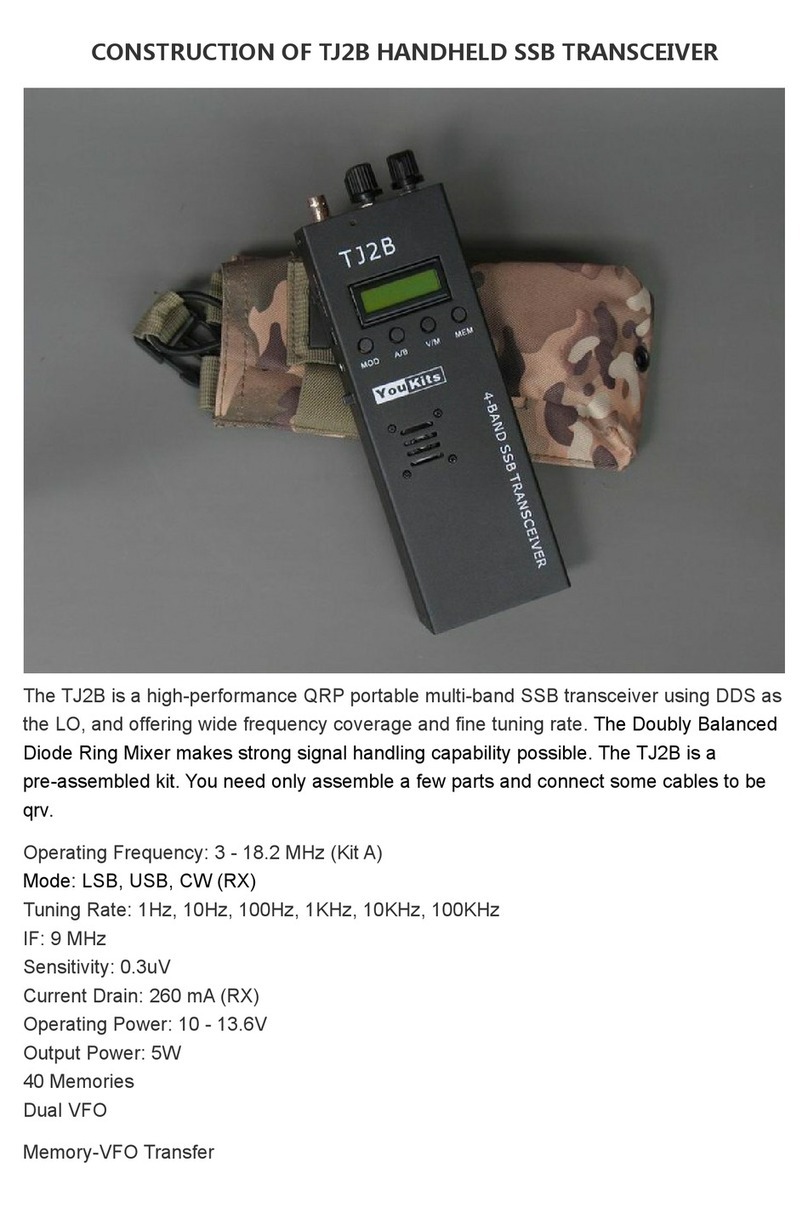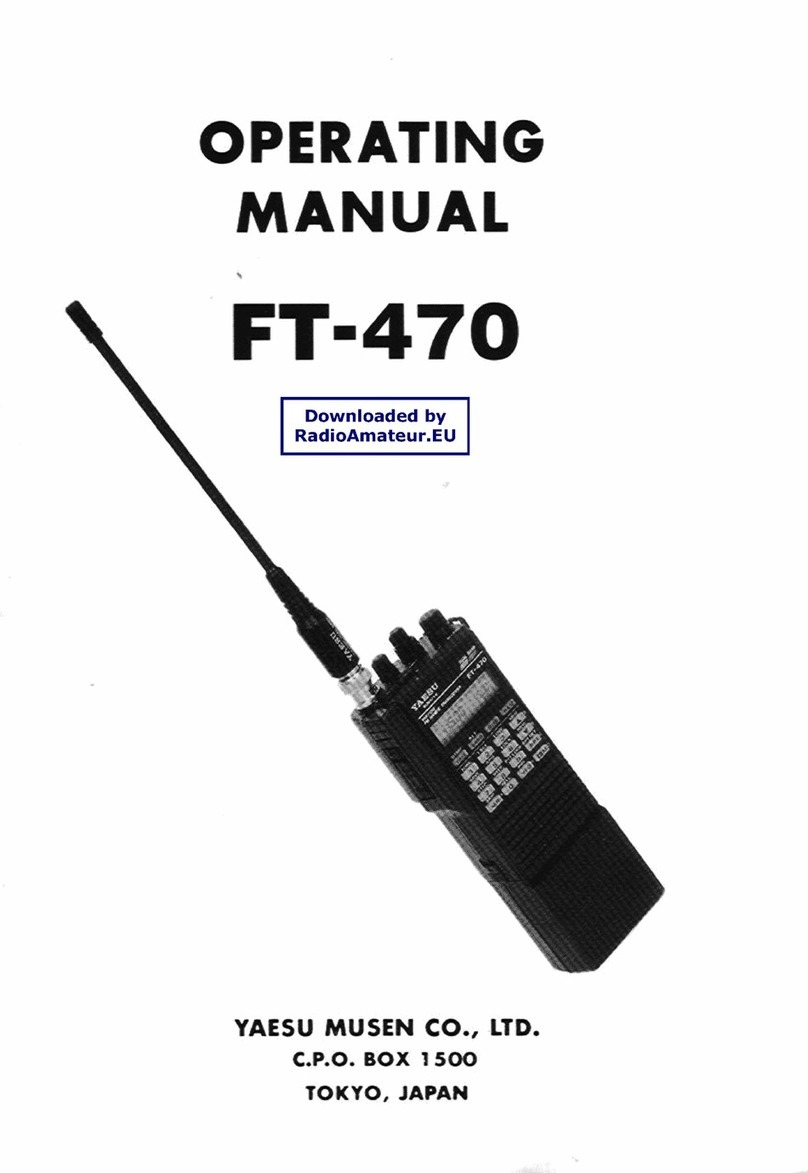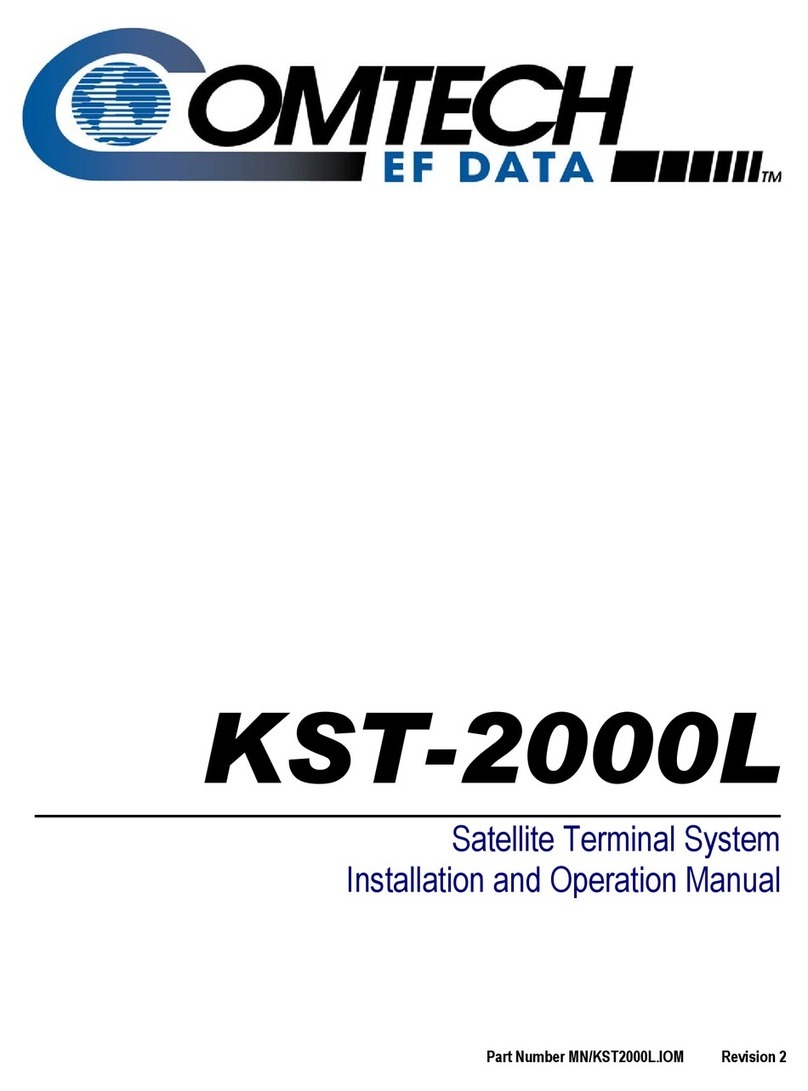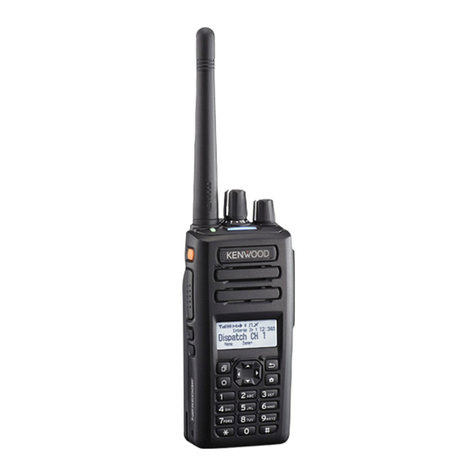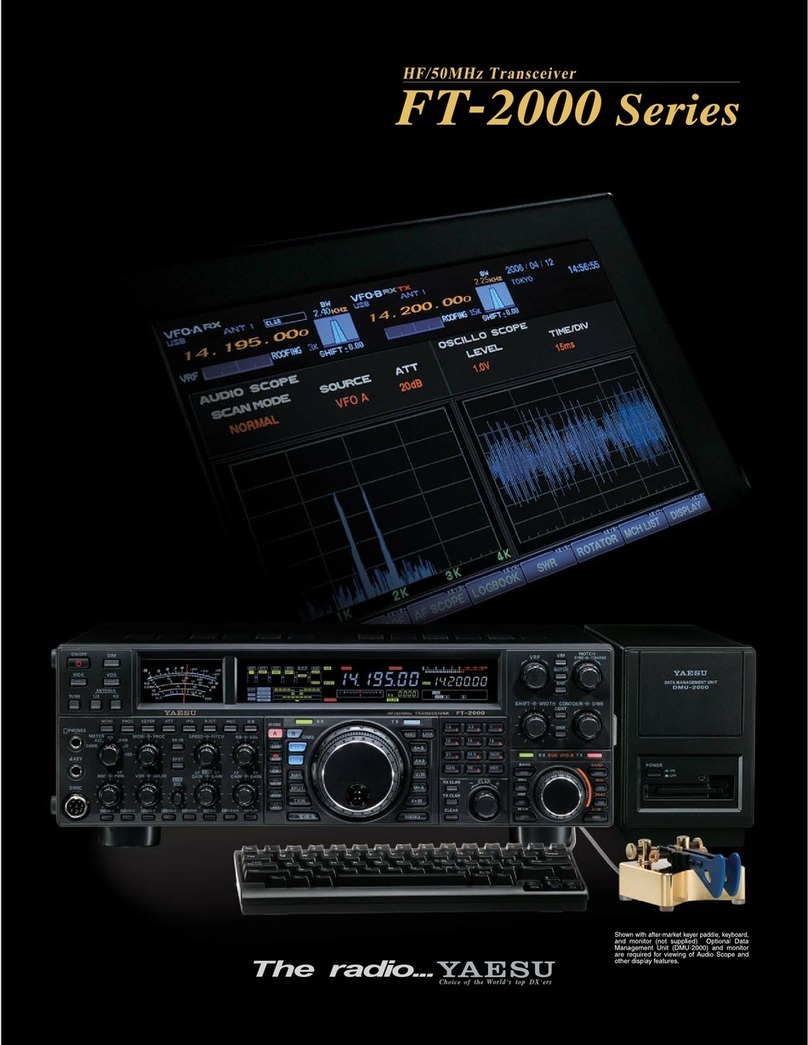Icom D-STAR ID-4100A Installation guide

DUAL BAND TRANSCEIVER
ID-4100A
ID-4100E
This device complies with Part 15 of the FCC rules. Operation is
subject to the following two conditions: (1) This device may not cause
harmful interference, and (2) this device must accept any interference
received, including interference that may cause undesired operation.
BASIC MANUAL
WARNING: MODIFICATION OF THIS DEVICE TO RECEIVE CEL-
LULAR RADIOTELEPHONE SERVICE SIGNALS IS PROHIBITED
UNDER FCC RULES AND FEDERAL LAW.

BASIC MANUAL
i
New2001New2001
Thank you for choosing this Icom product. This product is
designed and built with Icom’ s state of the art technology
and craftsmanship. With proper care, this product should
provide you with years of trouble-free operation.
This product combines traditional analog technologies with
the new digital technology, Digital Smart Technologies for
Amateur Radio (D-STAR), for a balanced package.
SUPPLIED ACCESSORIES
The following accessories are supplied with the transceiver.
DC power cable
(3 m: 9.8 ft)
Controller cable
(3.5 m:11.4 ft)
Microphone
(HM-207S)
Spare fuse
(FGB 15 A)
Microphone
hanger
EXPLICIT DEFINITIONS
WORD DEFINITION
RDANGER! Personal death, serious injury or an
explosion may occur.
RWARNING! Personal injury, re hazard or electric
shock may occur.
CAUTION Equipment damage may occur.
NOTE Recommended for optimum use. No risk
of personal injury, re or electric shock.
IMPORTANT
READ ALL INSTRUCTIONS carefully and completely
before using the transceiver.
SAVE THIS INSTRUCTION MANUAL— This instruction
manual contains basic operating instructions for the ID-
4100A/ID-4100E.
For Advanced features and instructions, see the Advanced
manual on the Icom website for details.
About E-marking:
Detailed installation notes for Icom mobile transceivers to
be tted into vehicles are available.
Please contact your Icom dealer or distributor.

BASIC MANUAL
New2001New2001
ii
ABOUT THE CONSTRUCTION OF THE MANUAL (As of May 2017)
Basic manual (This manual)
Instructions for the basic operations, precautions,
installations, and connections.
D-STAR Guide (Comes with the transceiver)
Instructions for registering your call sign to a gateway
repeater and the basic operations of D-STAR.
About the DV Gateway function (PDF type)
Instructions for the system requirements or operations to
use the DV Gateway function.
L“About the DV Gateway function” can be downloaded
from the Icom website.
Advanced manual (PDF type)
Instructions for the advanced operations, as shown below.
• Memory operation <Advanced>*
• Scan operation <Advanced>*
• Priority watch operation
• D-STAR operation <Advanced>*
• GPS operation
• Using a microSD card
• Voice memory operation
• Repeater and duplex operations
• Menu screen <Advanced>*
• Other functions
• Options <Advanced>*
• Bluetooth®operation
LThis manual can be downloaded from the Icom website.
*The basic instructions are described on this manual.
TIP:
• You can download each manual and guide from the Icom website, http://www.icom.co.jp/world/.
Enter ‘ID-4100’ into the Search box in the site.
• If necessary, you can see a glossary of HAM radio terms that can be downloaded from the Icom website.
• To read the guide or manual, Adobe Acrobat Reader is required. If you have not installed it, please download the Adobe
Acrobat Reader from Adobe Systems Incorporated’s website.
You can see the following manuals to use and understand this transceiver.

iii
New2001 New2001
BASIC MANUAL
OPTIONS (As of May 2017)
Microphone/Speaker
HM-154 hand microphone
HM-207S hand microphone (remote-control)
HM-209 noise canceling microphone
HM-232 hand microphone (simple)
OPC-440 mic extension cable: 5 m (16.4 ft)*
OPC-647 mic extension cable: 2.5 m (8.2 ft)*
SP-30 external speaker: 2.8 m (9.1 ft)*
SP-35 external speaker: 2 m (6.5 ft)*
SP-35L external speaker: 6 m (19.6 ft)*
*Approximate
Software
CS-4100 cloning software
RS-MS1A Android™ application
RS-MS1I iOS™ application
RS-MS3W
terminal mode/access point mode software:
For Windows
RS-MS3A
terminal mode/access point mode application:
For Android™ devices
OPC-2350LU data cable: USB type
OPC-478UC cloning cable: USB type
Bluetooth
UT-137 Bluetooth®unit
VS-3 Bluetooth®headset
Others
MBA-8 controller bracket
MBF-1 mounting base: MBA-8 is required
MBF-4 mobile bracket
OPC-345 dc power cable
OPC-589 mic adaptor cable
OPC-1156 controller extension cable: 3.5 m (11.4 ft)
Icom is not responsible for the destruction, damage to, or
performance of any Icom or non-Icom equipment, if the
malfunction is because of:
• Force majeure, including, but not limited to, res,
earthquakes, storms, oods, lightning, other natural
disasters, disturbances, riots, war, or radioactive
contamination.
• The use of Icom transceivers with any equipment that is
not manufactured or approved by Icom.

iv
New2001
BASIC MANUAL
TABLE OF CONTENTS BY TOPIC
Controller
Attaching/Installing .......................................................... 1, 2
Front panel .......................................................................... 9
Display................................................................................11
Power key.......................................................................... 19
Microphone
Connecting .......................................................................... 3
HM-207S ........................................................................... 16
Main unit
Connecting to a DC power supply....................................... 3
Installing in a vehicle ........................................................... 4
Installing an antenna ........................................................... 5
Front/Rear panel.......................................................... 14, 15
Bluetooth
Installing the UT-137............................................................ 7
Details of the Bluetooth operation ....................AM* (sec. 12)
microSD card
Inserting/Removing...................................................... 48, 50
Saving the setting data.......................................AM* (sec. 6)
MENU screen/Quick Menu
Quick Menu window .......................................................... 20
MENU screen description.................................................. 27
Menu item list .................................................................... 63
Details of the MENU screen ...............................AM* (sec. 9)
Memory channel
Memory channel operation................................................ 41
Details of the Memory channel operation...........AM* (sec. 1)
Scan
Scan operation .................................................................. 43
Setting and clearing a Skip channel .................................. 46
Details of the Scan operation .............................AM* (sec. 2)
GPS
GPS operation................................................................... 51
Checking your GPS position.............................................. 51
Details of the GPS operation..............................AM* (sec. 5)
D-STAR
Basic operation...............................................D-STAR Guide
Register your call sign at a gateway repeater
..D-STAR Guide
Details of the D-STAR operation ........................AM* (sec. 4)
*“AM” indicates the Advanced manual.

v
New2001 New2001
BASIC MANUAL
RDANGER HIGH VOLTAGE! NEVER touch the antenna
connector during transmission. This may result in an
electrical shock or burn.
RDANGER! NEVER operate the transceiver near
unshielded electrical blasting caps or in an explosive
atmosphere.
RDANGER! NEVER place the transceiver where air bag
deployment may be obstructed during mobile operations.
RWARNING RF EXPOSURE! This transceiver emits
Radio Frequency (RF) energy. Extreme caution should be
observed when operating this transceiver. If you have any
questions regarding RF exposure and safety standards
please refer to the Federal Communications Commission
Ofce of Engineering and Technology’s report on Evaluating
Compliance with FCC Guidelines for Human Radio
Frequency Electromagnetic Fields (OET Bulletin 65).
RWARNING! NEVER operate the transceiver while driving
a vehicle. Safe driving requires your full attention—anything
less may result in an accident.
RWARNING! NEVER operate the transceiver with an
earphone or other audio accessories at high volume levels.
Continuous high volume operation may cause a ringing in
your ears. If you experience ringing, reduce the volume level
or discontinue use.
RWARNING! NEVER connect the transceiver to an AC
outlet. This may pose a re hazard or result in an electric
shock.
RWARNING! NEVER connect the transceiver to a power
source of more than 16 V DC such as a 24 V DC battery.
This could cause a re or damage the transceiver.
RWARNING! NEVER reverse the DC power cable polarity
when connecting to a power source. This could damage the
transceiver.
RWARNING! NEVER operate the transceiver during a
lightning storm. It may result in an electric shock, cause a
re or damage the transceiver. Always disconnect the power
source and antenna before a storm.
RWARNING! NEVER cut the DC power cable between the
DC plug and fuse holder. If an incorrect connection is made
after cutting, the transceiver may be damaged.
RWARNING! NEVER let metal, wire or other objects touch
any internal part or connectors on the rear panel of the
transceiver. This may result in an electric shock or this could
cause a re or damage the transceiver.
RWARNING! NEVER operate or touch the transceiver
with wet hands. This may result in an electric shock or may
damage the transceiver.
PRECAUTIONS

vi
New2001
BASIC MANUAL
PRECAUTIONS
RWARNING! NEVER operate the transceiver if it emits an
abnormal odor, sound or smoke. Immediately turn OFF the
transceiver power and remove the power cable. Contact
your Icom dealer or distributor for advice.
RWARNING! NEVER place the transceiver where normal
operation of the vehicle may be hindered or where it could
cause bodily injury.
CAUTION: DO NOT expose the transceiver to rain, snow or
any liquids.
CAUTION: DO NOT change the internal settings of the
transceiver. This may reduce transceiver performance and/
or damage the transceiver.
CAUTION: DO NOT use harsh solvents such as Benzine
or alcohol to clean the transceiver, as they will damage the
transceiver’s surfaces. If the transceiver becomes dusty or
dirty, wipe it clean with a soft, dry cloth.
CAUTION: DO NOT place or leave the transceiver in
areas with temperatures below –10°C (+14°F) or above
+60°C (+140°F). Be aware that temperatures on a vehicle’s
dashboard can exceed +80°C (+176°F) in direct sunlight,
resulting in permanent damage to the transceiver if left there
for long periods of time.
CAUTION: DO NOT start the vehicle engine when the
transceiver's power is ON. Ignition voltage spikes can
damage the transceiver.
CAUTION: DO NOT use non-Icom microphones. Other
manufacturer’s microphones have different pin assignments,
and may damage the transceiver.
DO NOT push the PTT when not actually desiring to
transmit.
DO NOT place the transceiver in excessively dusty
environments or in direct sunlight.
DO NOT place the transceiver against walls or putting
anything on top of the transceiver. This will obstruct heat
dissipation.
DO NOT place the transceiver in an insecure place to avoid
inadvertent use by unauthorized persons.
DO NOT place the transceiver where hot or cold air blows
directly onto it, during mobile operation.
DO NOT operate the transceiver without running the
vehicle’s engine, during mobile operation. When the
transceiver’s power is ON and your vehicle’s engine is OFF,
the vehicle’s battery will soon become exhausted.
NOTE: During maritime mobile operation, keep the
transceiver and microphone as far away as possible from
the magnetic navigation compass to prevent erroneous
indications.
BE CAREFUL! The rear panel will become hot when
continuously operating the transceiver for long periods of
time.

BASIC MANUAL
vii
New2001 New2001
DWhen using the GPS receiver
• GPS signals cannot pass through metal objects. When
using the transceiver inside a vehicle, you may not receive
GPS signals. We recommend you use it near a window.
Please avoid the areas where:
1. The driver’s view will be blocked.
2. The air bags could deploy.
3. The unit becomes a driving obstacle.
• The Global Positioning System (GPS) is built and operated
by the U.S. Department of Defense. The Department is
responsible for accuracy and maintenance of the system.
Any changes by the Department may affect the accuracy
and function of the GPS system.
• When the GPS receiver is activated, please do not cover
the remote controller with anything that will block the
satellite signals.
• The GPS receiver may not work if used in the following
locations:
1. Tunnels or high-rise buildings
2. Underground parking lots
3. Under a bridge or viaduct
4. In remote forested areas
5. Under bad weather conditions (rainy or cloudy day)
IMPORTANT NOTES
DAbout GPS antenna
This transceiver’s GPS antenna is located at the top back
of the controller. If the controller’s rear panel is covered with
any object that interrupts the GPS signals from the satellites,
the GPS receiver will not calculate its position. Therefore,
when you are using the GPS feature, be sure the controller
is positioned so the antenna has a clear view to receive
signals from the satellites.
GPS
antenna
Controller
GPS antenna

BASIC MANUAL
New2001
viii
1
2
3
4
5
6
7
8
9
10
11
12
13
14
15
16
17
18
19
IMPORTANT NOTES
Icom, Icom Inc. and Icom logo are registered trademarks of Icom Incorporated
(Japan) in Japan, the United States, the United Kingdom, Germany, France,
Spain, Russia, Australia, New Zealand, and/or other countries.
Adobe, Acrobat, and Reader are either registered trademarks or trademarks of
Adobe Systems Incorporated in the United States and/or other countries.
The Bluetooth word mark and logos are registered trademarks owned by the
Bluetooth SIG, Inc. and any use of such marks by Icom Inc. is under license.
Other trademarks and trade names are those of their respective owners.
Android and the Android logo are trademarks of Google, Inc.
iOS is a trademark or registered trademark of Cisco in the U.S. and other
countries and is used under license.
All other products or brands are registered trademarks or trademarks of their
respective holders.
DMagnets
The optional MBA-8 controller bracket uses strong
magnets to attach the bracket to the controller’s rear panel.
DANGER! NEVER place or attach the magnets on
electronic medical equipment, such as an implanted cardiac
pacemaker. It may affect the operation of the equipment.
This could be life endangering.
BE CAREFUL not to pinch your nger when you attach the
bracket to the controller’s rear panel.
DO NOT put the controller near a clock, television set (CRT
type), magnetic compass or any magnetic/IC cards, credit
cards, and so on. The magnets may cause the products to
malfunction or may erase the contents of magnetic storage
devices.

ix
New2001 New2001
BASIC MANUAL
DÉFINITIONS EXPLICITES
MOT DÉFINITION
RDANGER !
Risque d'accident mortel, de
blessures corporelles graves ou
d'explosion.
RAVERTISSEMENT ! Risque de blessures corporelles,
d'incendie ou de choc électrique.
ATTENTION Risque de dégât matériel.
REMARQUE
Inconvénient seulement, en cas de
non-respect. Absence de risque de
blessures corporelles, d'incendie
ou de choc électrique.
PRÉCAUTIONS
RDANGER TENSION À HAUTES RF ! NE JAMAIS
toucher l'antenne en cours d'émission ou de réglage
d'accord. Au risque de provoquer un choc electrique ou des
brulures.
RDANGER ! NE JAMAIS utiliser l'émetteur-récepteur à
proximité de détonateurs électriques non blindés ou dans
une atmosphère explosive.
RDANGER ! NE JAMAIS placer l'émetteur-récepteur ni la
face avant a des emplacements ou ils pourraient entraver le
deploiement des airbags, en utilisation mobile.
RAVERTISSEMENT RELATIF À L'EXPOSITION AUX
FRÉQUENCES RADIO ! Cet appareil émet des ondes de
fréquences radio (RF). Il doit être utilisé avec la plus grande
prudence. Pour toutes questions concernant l'exposition
aux fréquences radio et sur les règles de sécurité, veuillez
consulter le rapport du Bureau Engineering and Technology
de la Federal Communications Commission (FCC) sur
l'évaluation de la conformité à la réglementation FCC sur
l'exposition de l'homme aux champs électromagnétiques de
fréquences radio (OET Bulletin 65).
RAVERTISSEMENT ! NE JAMAIS utiliser l'émetteur-
récepteur en conduisant un véhicule. La sécurité de la
conduite requiert toute l’attention du conducteur — toute
défaillance peut être à l’origine d’un accident.

x
New2001
BASIC MANUAL
PRÉCAUTIONS
RAVERTISSEMENT ! NE JAMAIS utiliser l'émetteur-
récepteur avec un casque ou tout autre accessoire audio à
un niveau sonore élevé. L’utilisation continue à un niveau
sonore élevé peut provoquer un bourdonnement dans vos
oreilles. Si vous entendez un bourdonnement baissez le
niveau du volume ou interrompez l'utilisation.
RAVERTISSEMENT ! NE JAMAIS relier l'émetteur-
récepteur à une prise CA. Cela pourrait provoquer un choc
électrique ou un incendie.
RAVERTISSEMENT ! NE JAMAIS connecter l’émetteur-
récepteur à une source d’alimentation de plus de 16 V CC,
tel qu’une batterie 24 V. Cela pourrait causer un incendie ou
endommager l'émetteur-récepteur.
RAVERTISSEMENT ! NE JAMAIS inverser la polarité lors
de la connexion du câble d’alimentation CC à une source
d’alimentation. Cela pourrait endommager l'émetteur-
récepteur.
RAVERTISSEMENT ! NE JAMAIS utiliser l'émetteur-
récepteur durant un orage. Cela risquerait de provoquer un
choc électrique, un incendie ou d'endommager l'émetteur-
récepteur. Toujours débrancher la source d'alimentation et
l'antenne avant une tempête.
RAVERTISSEMENT ! NE JAMAIS couper le câble
d’alimentation CC entre la prise CC à l’arrière de l’émetteur-
récepteur et le porte fusible. L’émetteur-récepteur peut être
endommagé par la suite en cas de connexion inappropriée.
RAVERTISSEMENT ! NE JAMAIS permettre que du
métal, du l ou d'autres objets soit au contact de l'intérieur
de l'émetteur-récepteur ou raccorder incorrectement les
connecteurs sur le panneau arrière. Cela pourrait provoquer
un choc électrique ou endommager l'appareil.
RAVERTISSEMENT ! NE JAMAIS utiliser ou toucher
l’émetteur-récepteur avec des mains mouillées. Cela
pourrait provoquer un choc électrique ou endommager
l'appareil.
RAVERTISSEMENT ! Coupez immédiatement le courant
de l'émetteur-récepteur et enlevez le câble d'alimentation
CC de l'émetteur-récepteur s'il émet une odeur, de la
fumée ou un bruit anormal. Contactez votre revendeur ou
distributeur Icom pour obtenir des conseils.
RAVERTISSEMENT ! NE JAMAIS placer jamais
l'émetteur-récepteur à un endroit pouvant gêner le
fonctionnement normal du navire, ou à un endroit où il
pourrait causer des blessures corporelles.
ATTENTION : NE PAS exposer l’émetteur-récepteur à la
pluie, à la neige ou à tout autre liquide.
ATTENTION : NE PAS changer les réglages internes de
l’émetteur-récepteur. Cela pourrait réduire les performances
de l'émetteur-récepteur ou l'endommager.

xi
New2001 New2001
BASIC MANUAL
ATTENTION : NE PAS utiliser de dissolvants agressifs tels
que du Benzène ou de l'alcool lors du nettoyage, car ils
endommageraient les surfaces de l'émetteur-récepteur. Si
l'émetteur-récepteur est poussiéreux ou sale, nettoyez-le
avec un tissu doux et sec.
ATTENTION : NE PAS utiliser ou placer l'émetteur-
récepteur dans des zones soumises à des températures
inférieures à –10°C (+14°F) ou supérieures a +60°C
(+140°F). Noter que la température au niveau de la plage
arrière ou du tableau de bord d’un véhicule peut dépasser
+80°C (+176°F), ce qui peut endommager irrémédiablement
la face avant de l’appareil en cas d’exposition prolongée.
ATTENTION : NE PAS Verier que l’appareil est eteint
avant d’actionner le demarreur du vehicule. Dans le cas
contraire, les pics de tension d’allumage du moteur risquent
d’endommager l'émetteurrécepteur.
ATTENTION : Utiliser exclusivement un microphone Icom
(fourni d’origine ou en option). La repartition des broches
des microphones des autres fabricants est différente et leur
connexion à l’ID-4100A/E peut endommager l’émetteur-
récepteur.
NE PAS appuyer sur la touche PTT sans intention réelle
d’émettre.
NE PAS placer l'émetteur-récepteur dans un environnement
excessivement poussiéreux ou en plein soleil.
NE PAS placer l'émetteur-récepteur contre un mur ou poser
des objets dessus. Cela risque de gêner la dispersion de la
chaleur.
NE PAS placer l'émetteur-récepteur dans un endroit peu sûr
pour éviter que des personnes non autorisées ne l'utilisent.
NE PAS placer l'émetteur-récepteur ni la face avant a des
emplacements ou ils pourraient etre directement exposes a
un ux d’air froid ou d’air chaud, en utilisation mobile.
NE PAS utiliser un émetteur-récepteur embarqué avec
le moteur du véhicule arrêté, en utilisation mobile. Toute
utilisation de l’émetteur-récepteur moteur arrêté a pour
conséquence de vider rapidement la batterie du véhicule.
REMARQUE : En utilisation maritime mobile, éloignez le
plus possible l'émetteur-récepteur et le microphone du
compas de navigation magnétique an d‘éviter d’en altérer
le fonctionnement.
MISE EN GARDE : Le panneau arrière de l'émetteur-
récepteur chauffe en cas d'utilisation continue sur une
longue durée.
MISE EN GARDE: Tout changement ou modication,
non expressément approuvé par Icom Inc., peut annuler
l'autorisation de l'utilisateur à utiliser cet appareil
conformément à la réglementation FCC.
PRÉCAUTIONS (Suite)

xii
New2001
BASIC MANUAL
Icom n'est pas responsable de la destruction ou
des dommages sur l'émetteur-récepteur Icom, si le
dysfonctionnement est causé par :
• Force majeure, sans toutefois s'y limiter, les incendies,
tremblements de terre, tempêtes, inondations, la foudre,
ou autres catastrophes naturelles, perturbations,
émeutes, guerre, ou contamination radioactive.
• L'utilisation de l'émetteur-récepteur Icom avec tout
équipement non fabriqué ou approuvé par Icom.
INFORMATION FCC
• POUR LES RAYONNEMENTS NON INTENTIONNELS
DE CLASSE B:
Cet équipement a été testé et reconnu conforme aux
limites xées pour un appareil numérique de classe B,
conformément au point 15 de la réglementation FCC.
Ces limites ont été xées an d'assurer une protection
raisonnable contre les interférences nocives dans une
installation résidentielle.
Cet équipement génère, utilise et peut émettre un
rayonnement de fréquence radio. S'il n'a pas été installé
conformément aux instructions, il peut par ailleurs créer
des interférences perturbant les communications radio.
Toutefois, il n'y a aucune garantie que les interférences ne
se produiront pas dans une installation particulière.
Si cet équipement crée des interférences perturbant la
réception de la radio ou de la télévision, comme cela peut
être déterminé en éteignant et en allumant l'équipement,
l'utilisateur est invité à essayer de corriger l'interférence en
prenant une ou plusieurs des mesures ci-après:
• Réorienter ou changer de place l'antenne de réception.
• Éloigner l'équipement et le récepteur.
• Connecter l'équipement sur une prise sur un autre circuit
que celui sur lequel le récepteur est connecté.
• Faire appel au revendeur ou à un technicien radio/TV
expérimenté.
MISE AU REBUT
Le pictogramme poubelle barrée sur notre
produit, notre documentation ou nos
emballages vous rappelle qu'au sein de l'Union
européenne, tous les produits électriques et
électroniques, batteries et accumulateurs
(batteries rechargeables) doivent être mise au
rebut dans les centres de collecte indiqués à la n de leur
période de vie. Vous ne devez pas mettre au rebut ces
produits avec les déchets municipaux non triés.
Ils doivent être mis au rebut dans le respect de la
réglementation en vigueur dans votre secteur.

BASIC MANUAL
xiii
New2001 New2001
TABLE OF CONTENTS
IMPORTANT ......................................................................... i
EXPLICIT DEFINITIONS....................................................... i
SUPPLIED ACCESSORIES.................................................. i
ABOUT THE CONSTRUCTION OF THE MANUAL............. ii
OPTIONS .............................................................................iii
TABLE OF CONTENTS BY TOPIC..................................... iv
PRECAUTIONS.................................................................... v
IMPORTANT NOTES..........................................................vii
DÉFINITIONS EXPLICITES................................................ ix
PRÉCAUTIONS.................................................................... x
INFORMATION FCC...........................................................xii
MISE AU REBUT.................................................................xii
1 INSTALLATION AND CONNECTIONS............ 1–8
■Attaching the controller ...............................................1
■Installing the controller................................................2
■Connecting a microphone...........................................3
■Connecting to a DC power supply ..............................3
■Installing in a vehicle...................................................4
■Installing an antenna...................................................5
■Connecting to a battery...............................................6
■Installing the UT-137...................................................7
■Electromagnetic Interference......................................8
2 PANEL DESCRIPTION................................... 9–18
■Controller — Front panel ............................................9
■Controller — Display.................................................11
■Main unit — Front panel ...........................................14
■Main unit — Rear panel ............................................15
■Microphone (HM-207S) ............................................16
3 BASIC OPERATION..................................... 19–26
■Turning ON the transceiver.......................................19
■Monitor function ........................................................19
■Setting audio volume and squelch level ...................19
■Quick Menu window..................................................20
■Selecting the Mode ...................................................21
■Selecting the operating band ....................................22
■Selecting the operating mode ...................................22
■Setting a frequency...................................................23
■Lock function.............................................................24
■DR function ...............................................................24
■Speech function ........................................................25
■Home Channel function ............................................25
■Transmitting ..............................................................26
4 MENU SCREEN............................................ 27–40
■MENU screen description .........................................27
■Selecting a Menu item ..............................................27
■Menu items and their details.....................................28

BASIC MANUAL
New2001
xiv
TABLE OF CONTENTS
5 MEMORY OPERATION................................ 41–42
■Entering Memory channels .......................................41
■Checking the Memory contents ................................41
■Selecting a Memory channel ....................................42
6 SCAN OPERATION...................................... 43–46
■VFO mode scan........................................................43
■Memory scan ............................................................45
■Setting and clearing a Skip channel .........................46
7 RECORDING A QSO ONTO A
microSD CARD ............................................ 47–50
■About the microSD card............................................47
■Inserting the microSD card .......................................48
■Removing the microSD card.....................................49
■Recording a QSO audio............................................50
■Playing recorded audio .............................................50
8 GPS OPERATION ........................................ 51–52
■GPS operation ..........................................................51
■Checking your GPS position.....................................51
9 MAINTENANCE............................................ 53–56
■Resetting...................................................................53
■Fuse replacement .....................................................54
■Power protect function ..............................................54
■Troubleshooting ........................................................55
10 SPECIFICATIONS ........................................ 57–58
11 INFORMATION ............................................. 59–60
■Country code list .......................................................59
■Disposal ....................................................................59
■FCC information........................................................60
12 INDEX ........................................................... 61–62
13 MENU ITEM LIST ......................................... 63–64

New2001
1
New2001New2001
INSTALLATION AND CONNECTIONS
1
BASIC MANUAL
■Attaching the controller
DWhen attaching to the main unit
Attaching:
Slide the controller in the direction of the arrow until the
controller is locked and makes a ‘click’ sound.
Detaching:
1. Push the release button on the main unit. (q)
2. Slide the controller to the left (w), then pull it out. (e)
DWhen connecting to the main unit
Connect the controller to the main unit with the supplied
control cable.
LThe following longer cables are usable, depending on the
installation location.
• OPC-440 mic extension cable: 5 m (16.4 ft)*
• OPC-647 mic extension cable: 2.5 m (8.2 ft)*
• OPC-1156 controller extension cable: 3.5 m (11.4 ft)*
• SP-30 external speaker: 2.8 m (9.1 ft)*
• SP-35 external speaker: 2 m (6.5 ft)*
• SP-35L external speaker: 6 m (19.6 ft)*
*Approximate
Main unit
Controller
Place the unit’s
tabs into the
controller’s slots.
w
q
e
Release button
Main unit
Controller
Main unit
6-pin connector
6-pin connector

2
1
INSTALLATION AND CONNECTIONS
New2001
1
BASIC MANUAL
New2001
3. Slide the MBA-8’s guide down over the MBF-1’s locking
head, as shown below.
L Be sure the locking head ts into the slot at the top of the
guide.
4. Tighten the lock knob to securely attach the controller.
5. Adjust the viewing angle of the controller, then tighten
the adjustment knob.
Guide
MBA-8
Lock knob
Locking head
(MBF-1)
Adjustment knob
■Installing the controller
DWhen installing into your vehicle
You can install the controller on the dashboard or the
console of your vehicle with the optional MBA-8 controller
bracket and the MBF-1 mounting base.
1. Attach the MBF-1 to the dashboard or the console.
LSee the MBF-1 instruction manual for details.
Magnet*
MBA-8
Longer
M2.6 × 8
screws*
Suction pad
Base lever
MBF-1
2. Attach the MBA-8 to the controller’s rear panel with
the supplied longer screws (M2.6 × 8 mm), as shown
below.
Controller
Controller
NOTE: There are 2 lengths (6 mm and 8 mm) of screws
supplied with the optional MBA-8 controller bracket.
• NEVER use any screws other than the supplied screws
(M2.6 × 8 mm) to attach the controller bracket. Otherwise
the transceiver’s internal board may be damaged.
• NEVER use any screws other than the supplied screws
(M2.6 × 6 mm) to attach the magnets. Otherwise the
transceiver’s internal board may be damaged.
*Supplied with the MBA-8.

3
1INSTALLATION AND CONNECTIONS
New2001 New2001
BASIC MANUAL
■Installing the controller (Continued)
DAttaching to a at surface
You can install the controller on a at surface with the optional
MBA-8 controller bracket. When attaching the MBA-8 to a
wall, use self-tapping screws*1(3 mm, 0.12 in (d)).
1. Attach the MBA-8 to a wall.
MBA-8
Self-tapping screw*1
(3 mm, 0.12 in (d))
■Connecting a microphone
Plug in the microphone into the microphone jack on the
main unit.
Controller
Main unit
Microphone
⊕
−
■Connecting to a DC power
supply
Conrm that the transceiver is
OFF, then connect to a 13.8 V
DC power source with at least
15 A capacity.
RWARNING! NEVER
remove the fuse holders from
the DC power cable.
When you attach a screw to this
hole, use a self-tapping screw*1
(4 mm, 0.2 in (d)).
2. Attach the magnets to the controller’s rear panel with
the supplied shorter screws (M2.6 × 6 mm).
DC power
supply 13.8 V
Red line: +
Black line: _
To an
AC
outlet
Fuses 15 A
CAUTION: DO NOT reverse
the polarity when connecting
the DC power cable.
*1User supplied
3. Attach the controller to the MBA-8 that is attached to a wall.
Magnet*2
Shorter
M2.6 × 6
screws*2
Controller
NEVER use any screws other than the supplied shorter
screws (M2.6 × 6 mm) to attach the magnets. Otherwise
the transceiver’s internal board may be damaged.
*2Supplied with the MBA-8.

4
1
INSTALLATION AND CONNECTIONS
New2001
1
BASIC MANUAL
■Installing in a vehicle
CAUTION: DO NOT place the main unit or remote
controller where normal operation of the vehicle may be
hindered or where it could cause bodily injury.
CAUTION: DO NOT place the main unit or remote
controller where air bag deployment may be obstructed.
CAUTION: DO NOT place the transceiver or remote
controller where hot or cold air blows directly onto it.
Controller DC power
cable
Battery
(12 V)
Controller
cable
Main unit
Installation example
You can install the main unit on the dashboard or the
console of your vehicle with the optional MBF-4 mobile
bracket.
1. Drill 4 holes where the mounting bracket is to be
installed.
LApproximately 5.5 ~ 5.6 mm (0.21 ~ 0.22 inch)(d) when
using nuts, approximately 2 ~ 3 mm (0.08 ~ 0.12 inch)(d)
when using self-tapping screws.
2. Insert the supplied screws, nuts and washers through
the mounting bracket and tighten.
3. Adjust the angle to suit your needs.
Mounting
nut
Nut
Spring washer
When using self-
tapping screws
Flat washer
Screw
25º
More than 100 mm
(3.9 inches) height
(recommended)
NOTE: Contact your car dealer or Icom dealer for advice
for installing in a vehicle.

5
1INSTALLATION AND CONNECTIONS
New2001 New2001
BASIC MANUAL
■Installing an antenna
To obtain maximum performance from the transceiver, select
a high-quality antenna and mount it in a good location.
Antenna location
NOTE:
• Make the coaxial cable as short as possible.
• Be sure to seal the antenna connection.
DAbout the antenna
For radio communications, the antenna is of critically
importance, along with output power and receiver sensitivity.
Select a well-matched 50 Ω antenna and coaxial cable
feedline. We recommend 1.5:1 or better Voltage Standing
Wave Ratio (VSWR) on your operating bands.
DAbout the internal duplexer
The transceiver has an internal duplexer, and you can easily
connect a dual band antenna (VHF/UHF).
If you connect separate the VHF and UHF antennas, use an
external duplexer.
When you connect VHF and UHF antennas separately:
Gutter-mount antenna
Roof-mount antenna
(Drill a hole or use a magnetic mount.)
Trunk-mount antenna
Connect the coaxial cable that the antenna is connected to
the antenna connector on the rear panel of the main unit.
Antenna connector
To the
Antenna connector
Main unit
Main unit
Duplexer
VHF UHF
Other manuals for D-STAR ID-4100A
3
This manual suits for next models
1
Table of contents
Other Icom Transceiver manuals
